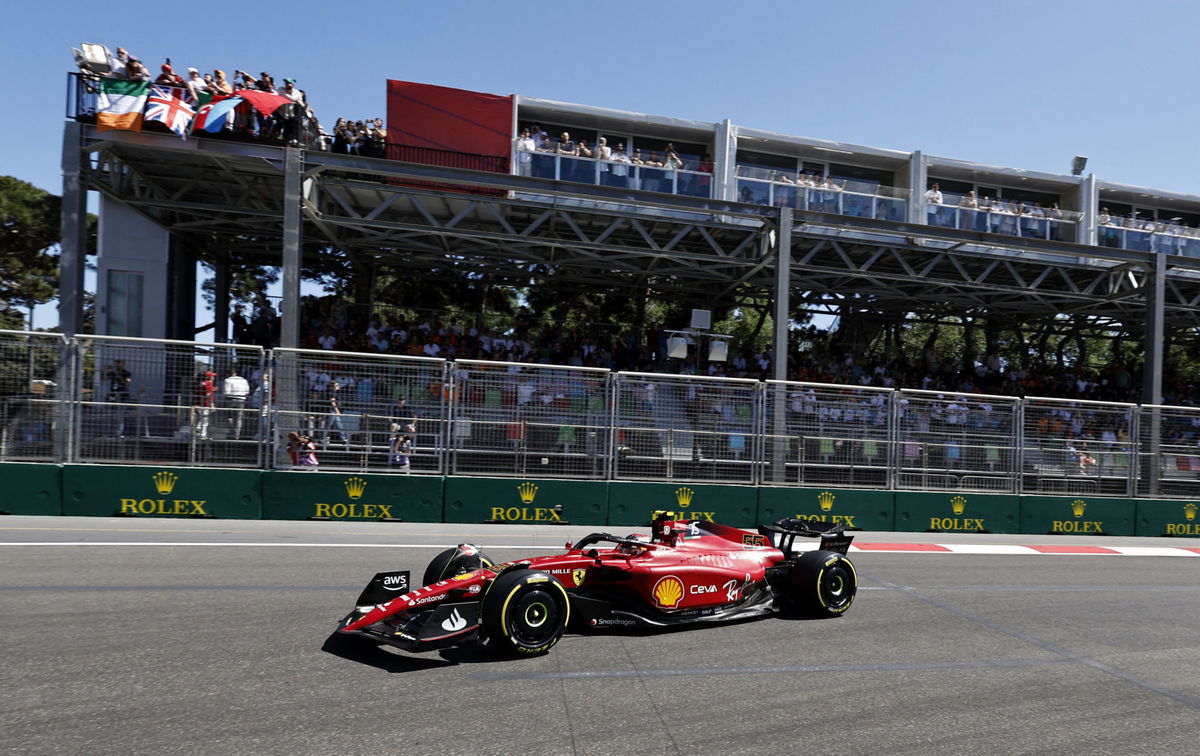
Reuters
Formula One F1 – Azerbaijan Grand Prix – Baku City Circuit, Baku, Azerbaijan – June 12, 2022 Ferrari’s Carlos Sainz Jr. in action during the race REUTERS/Hamad I Mohammed

Reuters
Formula One F1 – Azerbaijan Grand Prix – Baku City Circuit, Baku, Azerbaijan – June 12, 2022 Ferrari’s Carlos Sainz Jr. in action during the race REUTERS/Hamad I Mohammed
The Canadian Grand Prix kicked off with an interesting start as the FIA looked to limit porpoising. After many F1 drivers complained about the phenomenon after the race in Baku, the FIA decided to intervene in the matter. After the issuing of the new Technical Directive, there have been a lot of questions about what it means for performance and which teams will gain or lose the most.
Watch What’s Trending Now!
ADVERTISEMENT
Why did the FIA introduce such a rule in F1?
As per the FIA, Formula 1 teams will have to adhere to the buffer solution. While this is a short-term fix, given that the new cars will be around for a longer period of time, this cannot happen next year. Given it was during the middle of the season, the FIA did not want to alter the current standings of the championship. Hence, it is now up to the F1 teams to ensure the safety of their drivers. But also to figure out a way to extract performance from their cars.
ADVERTISEMENT
Pierre Gasly has been vocal about the dangers of porpoising after the Azerbaijan Grand Prix. Claiming that he would have to walk with a cane at 30 if this goes on, the French Formula 1 driver is happy to see the FIA step up. “I am very happy that the Federation has taken the views of us riders seriously, responding quickly with some measures,” he said. (Translated using Google.)

Reuters
Formula One F1 – Azerbaijan Grand Prix – Baku City Circuit, Baku, Azerbaijan – June 12, 2022 AlphaTauri’s Yuki Tsunoda in action during the race REUTERS/Hamad I Mohammed
“We already said it in Baku: it was important to act as soon as possible because it is a real problem for us drivers”.
ADVERTISEMENT
Top Stories
Honda Ruins Mercedes’ F1 2026 Domination Plans With $1.5T Worth Trump Card

Who Is Oscar Piastri’s Father, Chris Piastri? Co-Founder of Multibillion Dollar Automotive Company

3 Years After His Death, Niki Lauda’s Wife Brutally Disrespects Him to Initiate $32,000,000 Battle Against Own Children

Breaking Down Rebecca Donaldson’s Jaw Dropping Dating History: From Kardashian Debut to Dating F1 Star

Max Verstappen’s Siblings: Everything We Know About Victoria, Blue Jaye, Jason Jaxx, and Mila Faye

Speaking further, Gasly added that not a lot will change. Teams will have to make a few changes in regards to the directive and hence the pecking order could be the same. Pierre concluded that this was a good decision with respect to the health of Formula 1 drivers.
ADVERTISEMENT
Which teams are poised to take advantage of the new rule? And who will lose out?
Just as any changes are brought, some F1 teams will lose out while others won’t. Although it seems like Ferrari and Mercedes are set to be hurt the most, it is imperative to see how the new technical directive is implemented.
Since the last race in Baku, the FIA has been collecting data on the porpoising. While there hasn’t been a fixed set value to which the car can bounce, it will do so after the practice sessions in Canada. This will give Formula 1 teams the time they need to adapt and set up the car accordingly. Given that teams have not been able to study the changes in the simulator, it will be interesting to see who gets it right.
ADVERTISEMENT
The FIA steps in and issues a technical directive to reduce porpoising on safety grounds.
Includes “the definition of a metric, based on the car’s vertical acceleration, that will give a quantitative limit for acceptable level of vertical oscillations” #F1 #CanadianGP
— Chris Medland (@ChrisMedlandF1) June 16, 2022
Red Bull is expected to be the benefactor of this new rule. All season long their cars haven’t been victims of extreme porpoising. The Mercedes W13 works in a very narrow set-up window while the Ferrari F1-75 has a wider setup window and it could help to limit the losses.
WATCH THIS STORY: Everything You Need to Know About Daniel Ricciardo’s Famous Tattoos
ADVERTISEMENT
It is yet to be seen how teams will react, but this is definitely an interesting change mid-season. Do let us know your thoughts in the comments section.
ADVERTISEMENT
ADVERTISEMENT
ADVERTISEMENT

